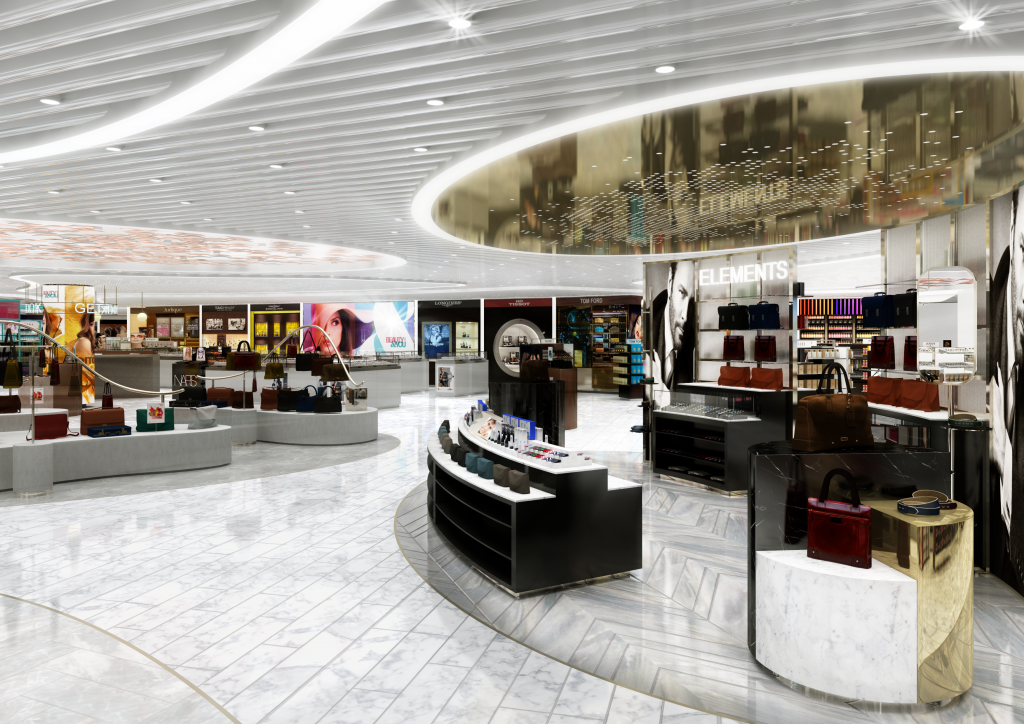Gregor Jackson, founding partner at London-based design agency gpstudio, takes us on a journey of discovery through duty free.
Traditional bricks and mortar retailing has generally recorded low single-digit growth for the past few years. Meanwhile, airport stores, alongside e-commerce, is in double-digit growth, with duty free shopping alone set to reach $64 billion in total revenue by 2020 (double this figure if taking into account other airport non-aviation revenue generators). Airports are an ascending market and a potential honeypot for retailers. But its future growth and future success will depend on a strategic development and significantly improved customer experience.
Not that long ago, airports offered travellers a poor and limited choice of F&B, and duty-free meant stocking up on cheap booze, cigarettes and distinctive triangular shaped chocolate, all in an overly lit environment, stacked high and resembling a wholesale warehouse. It has progressed over the last two decades into the world of ‘travel retail’, but even this is sometimes still viewed as a slightly derogatory retail term… as one of my clients does when referencing bad downtown retail design as ‘looking a bit travel retail’, he’s referencing a poor experience. And, in the case of airport travel, retail, often it is. Historically, it safely relied on being a protected environment, with a captive audience, and value-driven tax and duty free proposition that didn’t need the same thought and care as its downtown contemporaries.
But change is starting to occur. I must admit, as a frequent flyer for business and pleasure, I now find myself actually looking forward to the airport experience. No longer a place to just tolerate as part of the process of getting from A to B or even Z, I now have favourite airports, and within them favourite lounges, retail stores, restaurants and services. A percentage of my own spending has definitely shifted to the airport.

test
Despite this, change has been slow and in areas the bar set too low. The overall master planning and strategy of many airports (new or refurbishment) doesn’t appear to have fully embraced the future potential of an ‘aerotropolis super-infrastructure’, with retail and service as the lungs and travel as the heart. With retail, F&B and amenities within the airport, radiating out far beyond landside, – 34,000 ft above it – and not just appealing to consumers holding a boarding or landing card.
Reasonable scale is being achieved, and there are some terrific examples around the world, but a friction appears to exist between aviation, airport and tenants, that transcends into bland architecture and ultimately a lackluster passenger and consumer experience.
Airport shopping is no longer necessarily cheaper than the high street (never mind the online retail world), while consumers increasingly expect just as much from an airport shopping experience as they expect from an uber cutting-edge urban mall, and a purchase any time, any place, any where convenience. The often referred to ‘golden hour’ between security and boarding gate has the potential to be expanded not just in time but also in depth and breadth.
Digital plays a vitally important supporting role. Processing passengers through an airport is increasingly by means of digitalisation and self-service. Digital shopping can also seamlessly ease, enhance and broaden consumer engagement. From smartphone connectivity ‘talking’ to the frequent flyer, digital show rooming of products where space or stock-holding is at a premium, in-flight, through to the likes of ‘click and collect’ grocery or meal kits for those returning home or heading to Airbnb accommodation.

But with any retail, digital or physical, most importantly it needs to be a meaningful experience, not just brands and products presented against a bright and glitzy backdrop. Surveys suggest for more than 78 percent of airline passengers, travel represents to them the opportunity to explore the authentic culture of their chosen destination. Airport retail needs to examine and respond to the demographics and profiling of their consumers on an airport by airport basis, often even at the micro level of specific terminal or gate, to ensure in a global environment, consumers don’t meander through an airport fuzz with the same array of stores filled with the same brands in a ‘could be anywhere in the world’ state of mind. Any retailer that allows their product, design and environment to customise, be unique, and provide a sense of place – in a distinct physical village setting – will build an emotional connection with the consumer and commercial success will prevail. As we conceptually achieved with Shilla at Hong Kong International Airport.
Eating is often referred to as the new retail. And certainly the elevated choice of F&B, and diversification at airports has rocketed over the last decade, with further growth and innovation possible. I’m seeing on my travels Martini bars, gourmet pop-corn shacks, and restaurants offering everything from wagyu and blue cheese burgers, sushi to crab-cake sliders now sitting alongside each other to tempt me (and fellow passengers). An international offering is expected, yet most importantly a local food mix for placement is essential. While the overall master planning needs to take into account and carefully allow a balance between restaurant ‘dwell’ and retail ‘spending’. Or digitally combine the two. I’d happily shop online while sitting at a Martini bar then collecting my purchases at the gate!
Travel retail is not just at home within an airport, and many have made their way downtown, and visa versa; the downtown mall operator into the airport. If airport travel retail is to continue accelerating its success, it needs to define itself through developing a density of retail, F&B and amenities – the aerotropolis I mentioned earlier. Allow digital to act as the solar system around it, convert browsers into buyers through engaging and unique experiences, create a sense of place, and appeal to a wider yet specific passenger audience, and consider the non-traveller as a consumer as well – and throughout the customer journey: booking; airport; flying; and destination, providing a ‘total retail’ experience
